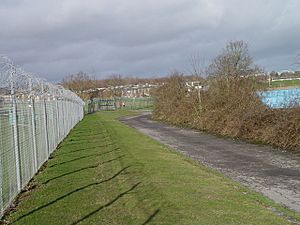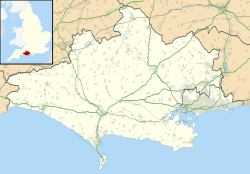Blandford Camp facts for kids
Quick facts for kids Blandford Camp |
|
|---|---|
| Near Blandford Forum, Dorset in England | |

Part of Blandford Camp seen from a nearby tumulus
|
|
|
Shown within Dorset
|
|
| Coordinates | 50°52′N 2°07′W / 50.867°N 2.117°W |
| Type | Army base |
| Site information | |
| Owner | Ministry of Defence |
| Operator | British Army |
| Controlled by | Royal Signals |
| Site history | |
| Built | 1724 |
| In use | 1724-present |
Blandford Camp is a military base located in Dorset, southern England. It covers about 390 hectares (which is like 960 football fields!) of open land, just 2 miles (3 km) north-east of Blandford Forum.
Some parts of the camp are special natural areas called Sites of Special Scientific Interest (SSSI). This means they are protected because of their important wildlife or geology.
Today, Blandford Camp is the main home for the Royal Signals. This is the part of the British Army that handles all communications. The camp has their main office, the Defence College of Communications and Information Systems (DCCIS), and the Royal School of Signals. You can also find the Royal Signals Museum here, which is a great place to learn about military communications history.
Over the years, this camp has been used by many different groups. These include the Royal Navy, Royal Air Force, and the British Army. It even hosted a US Army hospital during a big war. The site was also once used as a track for car and motorcycle races!
History of Blandford Camp
There are many ancient sites within the camp, showing people lived here long ago. But the first recorded use of this land was as a racecourse. This is why one area is still called Race Down. Horse races were held here from the late 1500s until the late 1800s.
Early Military Use (1700s-1800s)
Soldiers have likely used this area for centuries. The first clear record of military use was in the 1700s. Local volunteer groups trained here. In 1724, a group of Hussars (a type of soldier) were based here to stop smuggling.
In 1756, during the Seven Years' War, a large army of about 10,000 men gathered near Blandford. They held major training exercises on Blandford Downs, where the camp is now. This was to prepare for a possible French invasion.
In 1806, a special Shutter Telegraph Station was built near the racecourse. This station helped send messages from London to the naval base in Plymouth. It was part of a long chain of signal stations. The station closed in 1816 after the Napoleonic Wars ended.
Throughout the 1800s, Blandford Race Down continued as a training area. Local volunteer soldiers used it, and a permanent rifle range was built.
When World War I began, many Royal Naval reservists were called up. There were more sailors than needed for ships, so a special Royal Naval Division was formed. After fighting in Belgium, this division set up a training camp at Blandford. A German prisoner of war camp was also built nearby.
The Royal Naval Division had battalions named after famous naval officers like Drake and Nelson. The camp areas were also named after them. Soldiers practiced building trenches and fighting in them. You can still see traces of these old trenches in the camp today.
Many men from the division left Blandford Camp for the Gallipoli Campaign. This was a very difficult operation. A memorial now stands at Collingwood Corner, dedicated to the soldiers who died there in 1915.
Royal Flying Corps and Royal Air Force
In 1918, the camp became an 'Intake Camp' for the Royal Flying Corps. This group was becoming the Royal Air Force. A special railway line was built to bring supplies and people to the camp. It connected to the main railway line near Blandford Forum.
However, by the end of 1919, the camp closed. All the wooden huts and the railway line were removed. By 1920, the land was used for farming again.
Second World War
As World War II approached, the camp was reopened in 1939. It became a training center for reservists. New wooden huts were built on the same spots as the old ones. A few of these 1939 huts are still there today.
After the Battle of France, the British Army reorganized. Anti-aircraft units and reconnaissance battalions trained at Blandford. The camp then became a Battle Training Camp. Soldiers trained here for a month before being sent to combat areas like North Africa. They also prepared for the invasion of Normandy in 1944.
US Army Hospital Complex
Once the invasion of Europe began, Blandford Camp was no longer needed for training. So, it was turned into a US Army hospital complex. In April 1944, the first of five US Army hospitals opened here.
The hospitals started receiving injured soldiers about two weeks after D-Day. Many came from the battle areas through the nearby Tarrant Rushton airfield. The hospitals were very busy, sometimes receiving 500 injured people in one night. The hospital complex closed after VE Day in 1945. Most of the staff returned to the USA by October 1945.
The Roosevelt Garden and Memorial were dedicated in the camp on May 30, 1945. A special service is held there every November to remember those who died.
Post-War Years
After the hospitals closed, the camp became a training camp again. From 1946 to 1962, it was used by different army groups. These included the Royal Army Service Corps, Royal Electrical and Mechanical Engineers, and the Army Catering Corps.
Blandford Motor Racing Circuit

A view just outside the circuit, which crosses from the blue fence on the right beyond the hedge and through where the gate now stands in the centre. This point on the track was called "The Dip"
|
|
| Location | Dorset, England |
|---|---|
| Time zone | GMT |
| Opened | 25 July 1948 |
| Closed | December 1960 |
| Major events | Formula Two Road Racing Motorcycle Racing |
| Length | 5.05 km (3.14 mi) |
| Turns | 6 |
On July 25, 1948, the camp's 3-mile (5 km) perimeter road became the UK's first post-war road racing circuit. About 10,000 people watched the first event, a motorcycle race. The fastest lap was set by Bob Foster, going over 85 mph (137 km/h).
By April 1949, the circuit was known as the fastest in the country. Speeds over 110 mph (177 km/h) were reached on the straight parts. Car races also began here, and the circuit was approved for them.
However, some races had serious accidents. In September 1949, a motorcycle race saw one rider die and several others injured. These accidents were often blamed on riders' lack of experience. There were also complaints about delays and getting into the military base for events. Some local people also started to oppose the races.
Another international motorcycle race in April 1950 attracted over 40,000 spectators. But again, two riders were killed. After this, a judge said he hoped the military would not allow more races. He criticized the lack of safety barriers around the track.
Despite these concerns, two more car races happened without problems. But on July 29, a popular driver named Joe Fry was killed during practice for a hill climb event. His car crashed into a bank and hit a metal stake. The judge was very critical, saying nothing had changed despite earlier warnings. He declared that "Blandford racing is going to end." Soon after, the army announced that no more car or motorcycle races would be allowed.
One final motorcycle event was allowed in August. It passed safely, and Geoff Duke set a new lap record of 91.03 mph (146.50 km/h).
After discussions, the ban was lifted for a trial period. But on May 14, 1951, another serious accident occurred. Two riders crashed, and one of their motorcycles hit a soldier and a Red Cross worker. The Red Cross worker died from his injuries.
Following this, a tight chicane (a sharp turn) was added to slow down speeds. Motorcycle events continued until the circuit closed in 1961 because the army camp needed more space.
Royal Signals Take Over
In 1960, 30 Signal Regiment moved to Blandford. The camp was then chosen to be the new home for the School of Signals, which moved there in 1967. This school trains officers and non-commissioned officers (NCOs) in communications.
In the early 1990s, more Royal Signals training moved to Blandford. The main office of the Royal Corps of Signals also moved here from London. Now, all special training for Royal Signals soldiers happens at Blandford.
In 2007, there were plans to move all communications training from Blandford to a new site. However, the government said there were no plans to close Blandford Camp. It is expected to continue being used for defence purposes.
Current Units at Blandford Camp
Here are some of the groups and units based at Blandford today:
Ministry of Defence
- Defence College of Communications and Information Systems (HQ)
- Craddock Training Area
Strategic Command
- Specialist Group Information Services
British Army
- Headquarters, Royal Corps of Signals
- 11th (Royal School of Signals) Signal Regiment, Royal Corps of Signals
- Regimental Headquarters
- 4 (Military Training) Squadron
- 5 (Maresfield) Squadron
- 13th Signal Regiment
- Regimental Headquarters
- 224 (Cyber Protection Team) Signal Squadron
- 259 (Global Information Services) Signal Squadron – (This unit includes members from different services)
- Combat Information Systems (CIS) Trails and Development Unit (CISTDU)
- 15th Signal Regiment, Royal Corps of Signals
- Regimental Headquarters
- 207 (Jerboa) Signal Squadron
- 255 (Bahrain) Signal Squadron
- Support Squadron
- 280 (United Kingdom) Signal Squadron, Royal Corps of Signals
- Blandford Garrison Support Unit, Royal Corps of Signals
- Royal Corps of Signals Training Development Team
Notable Connections
- Sub Lieutenant Rupert Brooke (1887–1915): A famous poet who was stationed at Blandford from November 1914 to February 1915. Some of his best-known poems are thought to have been written here.
- Joe Fry (1915–1950): A British racing car driver. He was sadly killed in an accident at the Blandford hill-climb race in 1950.
See also
 In Spanish: Blandford Camp para niños
In Spanish: Blandford Camp para niños


